Onion Seed Production: Quick Reference - Organic Seed Alliance
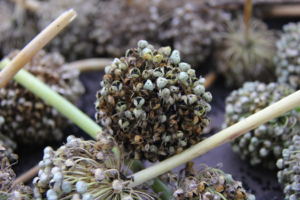
Onion Seed Production
Onions are a biennial, so seed production must take into account a two-year reproductive cycle.
Year 1: Producing the onion crop
Onions prefer dry hot summers and develop best in sandy or silty loam soils with high water-holding capacity and a consistent water supply. They require high nitrogen and phosphorus, but excess nitrogen can be detrimental. Since onion seed populations need to be in the range of 120-200 plants, a greater number of bulbs will be needed the first year to account for any selection and bulbs that deteriorate during winter storage. A good number of onion plants for the first year might be 250-300. Plant transplants 3-4 inches apart to provide room for bulb formation. After the bulbs have formed, selections can be made based on important traits for the population. After 50% of the tops have fallen over, knock the rest down and wait a few days before digging the bulbs up and windrowing them for 1-2 weeks. Turn bulbs to avoid sunburn. The best onion bulbs should have their tops cut and be stored in burlap sacks in a humid (65-75% relative humidity, RH), cool (32-34°F) area with good air circulation.
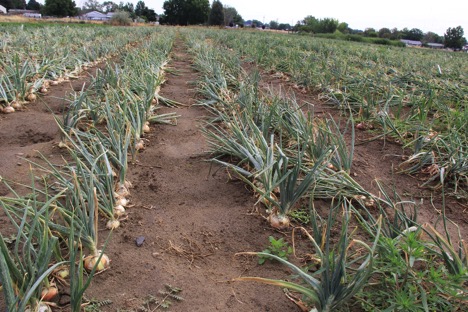
Year 2: Producing the onion seed
Since onion is highly outcrossing and insect-pollinated, it should be isolated from other onion varieties by at least 0.5-1 mile. More distance is necessary if varieties are different colors and/or different shapes. Select onion bulbs that have no disease, sprouting, or elongation after storage for planting. If selecting for single centers or other internal qualities, cut the top third of each bulb off horizontally to evaluate internal characteristics before planting. Allow selected bulbs to sit and heal over for 2-3 days before transplanting.
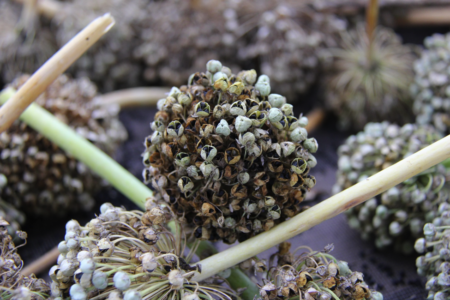
At least 120 plants should be used to maintain population integrity. The bulbs should be planted 12 inches apart in rows that are 18-24 inches apart. Plants may need to be staked to avoid falling over or to protect them from being knocked over by wind. Clear, warm weather is beneficial for pollination, and temperatures between 65°F and 95°F are best for seed set. Overhead watering can increase the potential for disease and should be avoided during flowering and seed set. Approximately 3-4 weeks after fertilization seed enters the “dough stage.” Three more weeks after that the seed should be mature. Begin harvesting once the capsules are open and the black seeds are visible. Cut seed heads 4-6 inches below the umbel and lay on landscape cloth. Allow to dry for up to 2 weeks and turn to avoid sunburn if in direct sun. It may take 2-3 weeks to harvest all bulbs as flower maturity can be variable. Thresh the seed by rubbing by hand, through screens, or combining. A combination of winnowing and screening will be needed to get the seed fully clean. For lots with low germination or persistent bracts and stems, flotation may be a useful technique as the bracts, stems and immature seeds will float and can be easily skimmed off. If flotation is used, dry the seed immediately and do not allow seed to be immersed in water any longer than is necessary. In other words, don’t start the process unless you intend to finish it.
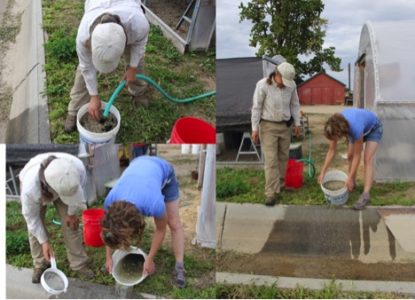
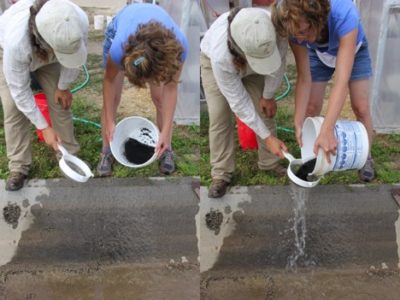
Onion seed dried to 6.5% moisture and stored under favorable conditions (40-60°F and <40%RH) will last 1-2 years. Properly dried seed that is stored in a freezer will keep indefinitely.
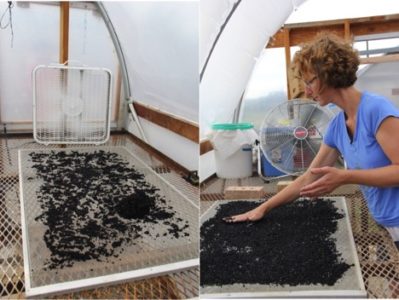
Selection and Variety Improvement
Because of the 2-year reproductive cycle, traits will be evaluated during both bulb production and storage to improve the population.

| Trait | Timing |
| Seedling vigor | 2-3 weeks after seedling emergence |
| Early bulb formation | Early summer |
| Uniformity of neck falldown | Late summer, 1-2 weeks before harvest |
| Neck closure | Anytime after field curing |
| Bulb shape | Anytime after field curing |
| Bulb color & intensity | Anytime after field curing |
| Bulb uniformity | Anytime after field curing |
| Skin/wrapper quality | Anytime after field curing |
| Days to maturity | At harvest |
| Yield: total & marketable (whole plot & weight per bulb) | Anytime after field curing |
| Disease resistance | During growing season and after harvest |
| Insect resistance | During growing season and after harvest |
| Bulb firmness | Periodically throughout winter, 2-8 months after harvest |
| Sprouting resistance | Periodically throughout winter, 2-8 months after harvest |
| Storagability | Periodically throughout winter, 2-8 months after harvest |
| Flavor | Soon after harvest, and again after several months in storage |
Disease
Plant disease-free seed. Grow onions in well-drained soils. Thoroughly cure and dry bulbs after harvest: undercut or pull mature bulbs and leave in the field for 1-2 weeks followed by well ventilated storage and curing in a covered shed or greenhouse. Save only fully mature, well-cured bulbs. Avoid damaging or bruising the bulbs. Bury or compost any culled bulbs. Use a 3-4 year crop rotation if possible before producing onions on the same ground again. Store the bulbs at 33-40°F and 70-75%RH. Diseases are classified by severity with a class of 1 being the most severe and 3 the least severe.
| Disease | Type | Severity class | Favorable conditions |
| Neck rot (Botrytis aclada) | Seedborne | 1 | Storage of immature bulbs with green, soft necks |
| Black mold (Aspergillus niger) | Seedborne | 2 | Storage of immature, soft bulbs |
| Smudge (Colletotrichum circinans) | Seedborne | 3 | Warm (80°F) and moist at harvest time |
| Botrytis blight (Botrytis cinerea) | Seedborne | 3 | Moderately warm (65-80°F) and extended wet period |
| Basal rot (Fusarium oxysporum, sp. cepae) | Seedborne | 3 | Soil temperatures 57-90°F, optimum 80°F |
| Stemphylium leaf blight (Stemphylium vesicarium) | Seedborne | 3 | Moderate temperature (70-80°) and heavy dew, fog or rain |
| Purple blotch (Alternaria porri) | Seedborne | 3 | Moderate temperature (70-80°) and heavy dew, fog or rain |
| Downy mildew (Peronospora destructor) | Foliar | ||
| Pink root (Pyrenochaeta terrestris) | Root | ||
| Onion smut (Urocystes cepulae) | Foliar | ||
| Onion thrips (Thrips tabaci) | Insect | ||
| Onion maggots (Hylemyia antiqua) | Insect |
This resource was made possible thanks to the Montana Department of Agriculture’s Specialty Crop Block Grant Program.

